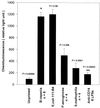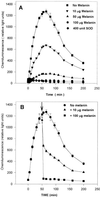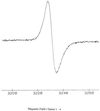A melanin pigment purified from an epidemic strain of Burkholderia cepacia attenuates monocyte respiratory burst activity by scavenging superoxide anion
- PMID: 9916107
- PMCID: PMC96403
- DOI: 10.1128/IAI.67.2.908-913.1999
A melanin pigment purified from an epidemic strain of Burkholderia cepacia attenuates monocyte respiratory burst activity by scavenging superoxide anion
Abstract
The acquisition of Burkholderia cepacia in some cystic fibrosis patients is associated with symptoms of acute pulmonary inflammation that may be life threatening. The ability of lipopolysaccharide (LPS) from B. cepacia to prime a monocyte cell line for enhanced superoxide anion generation was investigated and compared with the priming activities of LPSs from Pseudomonas aeruginosa, Stenotrophomonas maltophilia, and Escherichia coli. The human monocyte cell line MonoMac-6 (MM6) was primed overnight with different LPSs (100 ng/ml), and the respiratory burst was triggered by exposure to opsonized zymosan (125 micrograms/ml). Superoxide generation was detected by enhanced chemiluminescence with Lucigenin. B. cepacia LPS was found to prime MM6 cells to produce more superoxide anion than P. aeruginosa or S. maltophilia LPS, and this priming response was CD14 dependent. In addition, the inhibition of respiratory burst responses in monocytes by a bacterial melanin-like pigment purified from an epidemic B. cepacia strain was investigated. The melanin-like pigment was isolated from tyrosine-enriched media on which B. cepacia had been grown and was purified by gel filtration, anion ion-exchange chromatography, and ethanol precipitation. The scavenging potential of the melanin-like pigment for superoxide anion radical (*O2-) generated during the respiratory burst was confirmed with superoxide produced from a cell-free system with xanthine-xanthine oxidase and detected by electron paramagnetic resonance spectroscopy with the spin trap 5-diethoxyphosphoryl-5-methyl-1-pyrroline-n-oxide. The addition of melanin during the LPS priming stage had no effect on the subsequent triggering of the respiratory burst, but melanin inhibited *O2- detection when added at the triggering stage of the respiratory burst. We conclude that melanin-producing B. cepacia may derive protection from the free-radical-scavenging properties of this pigment.
Figures





Similar articles
-
Lipopolysaccharide (LPS) from Burkholderia cepacia is more active than LPS from Pseudomonas aeruginosa and Stenotrophomonas maltophilia in stimulating tumor necrosis factor alpha from human monocytes.Infect Immun. 1999 Mar;67(3):1505-7. doi: 10.1128/IAI.67.3.1505-1507.1999. Infect Immun. 1999. PMID: 10024601 Free PMC article.
-
Priming of neutrophil respiratory burst activity by lipopolysaccharide from Burkholderia cepacia.Infect Immun. 1997 Oct;65(10):4281-7. doi: 10.1128/iai.65.10.4281-4287.1997. Infect Immun. 1997. PMID: 9317038 Free PMC article.
-
Lipopolysaccharide chemotypes of Burkholderia cepacia.J Med Microbiol. 1999 Sep;48(9):825-832. doi: 10.1099/00222615-48-9-825. J Med Microbiol. 1999. PMID: 10482293
-
The emergence of epidemic, multiple-antibiotic-resistant Stenotrophomonas (Xanthomonas) maltophilia and Burkholderia (Pseudomonas) cepacia.J Hosp Infect. 1995 Jun;30 Suppl:453-64. doi: 10.1016/0195-6701(95)90049-7. J Hosp Infect. 1995. PMID: 7560984 Review.
-
Burkholderia cepacia: medical, taxonomic and ecological issues.J Med Microbiol. 1996 Dec;45(6):395-407. doi: 10.1099/00222615-45-6-395. J Med Microbiol. 1996. PMID: 8958242 Review.
Cited by
-
VanT, a homologue of Vibrio harveyi LuxR, regulates serine, metalloprotease, pigment, and biofilm production in Vibrio anguillarum.J Bacteriol. 2002 Mar;184(6):1617-29. doi: 10.1128/JB.184.6.1617-1629.2002. J Bacteriol. 2002. PMID: 11872713 Free PMC article.
-
Comparative genome-wide analysis reveals that Burkholderia contaminans MS14 possesses multiple antimicrobial biosynthesis genes but not major genetic loci required for pathogenesis.Microbiologyopen. 2016 Jun;5(3):353-69. doi: 10.1002/mbo3.333. Epub 2016 Jan 14. Microbiologyopen. 2016. PMID: 26769582 Free PMC article.
-
Opsonized virulent Edwardsiella tarda strains are able to adhere to and survive and replicate within fish phagocytes but fail to stimulate reactive oxygen intermediates.Infect Immun. 2001 Sep;69(9):5689-97. doi: 10.1128/IAI.69.9.5689-5697.2001. Infect Immun. 2001. PMID: 11500445 Free PMC article.
-
Characterization of 2-(2-nitro-4-trifluoromethylbenzoyl)-1,3-cyclohexanedione resistance in pyomelanogenic Pseudomonas aeruginosa DKN343.PLoS One. 2017 Jun 1;12(6):e0178084. doi: 10.1371/journal.pone.0178084. eCollection 2017. PLoS One. 2017. PMID: 28570601 Free PMC article.
-
Sword and shield: linked group B streptococcal beta-hemolysin/cytolysin and carotenoid pigment function to subvert host phagocyte defense.Proc Natl Acad Sci U S A. 2004 Oct 5;101(40):14491-6. doi: 10.1073/pnas.0406143101. Epub 2004 Sep 20. Proc Natl Acad Sci U S A. 2004. PMID: 15381763 Free PMC article.
References
-
- Agodi A, Stefani S, Corsaro C, Campanile F, Gribaldo S, Sichel G. Study of melanic pigment of Proteus mirabilis. Res Microbiol. 1996;147:167–174. - PubMed
-
- Albrecht D, Jungi T W. Luminol-enhanced chemiluminescence induced in peripheral blood-derived human phagocytes: obligatory requirement of myeloperoxidase exocytosis by monocytes. J Leukocyte Biol. 1993;54:300–306. - PubMed
-
- Allen R C. Phagocytic leukocyte oxygenation activities and chemiluminescence: a kinetic approach to analysis. Methods Enzymol. 1986;133:449–493. - PubMed
-
- Allen R C, Stjernholm R L, Steele R H. Evidence for the generation of (an) electronic excitation state(s) in human polymorphonuclear leukocytes and its participation in bactericidal activity. Biochem Biophys Res Commun. 1972;47:679. - PubMed
-
- Baehner R L, Nathan D G. Leukocyte oxidase: defective activity in chronic granulomatous disease. Science. 1967;155:835–836. - PubMed
MeSH terms
Substances
LinkOut - more resources
Full Text Sources
Other Literature Sources
Molecular Biology Databases
Research Materials

